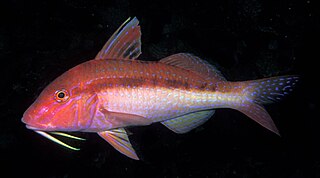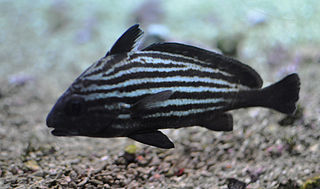
Menticirrhus is a genus of marine ray-finned fish belonging to the family Sciaenidae, the drums or croakers. They are commonly known as kingcroakers or kingfish. These fish are found in the Western Atlantic and Eastern Pacific Oceans.

Merlangius merlangus, commonly known as whiting or merling, is an important food fish in the eastern North Atlantic Ocean and the northern Mediterranean, western Baltic, and Black Sea. In Anglophonic countries outside the whiting's natural range, the name "whiting" has been applied to various other species of fish.

The gag grouper, also known as velvet rockfish, the gag, or charcoal belly, is a species of marine ray-finned fish, a grouper from the subfamily Epinephelinae which is part of the family Serranidae, which also includes the anthias and sea basses. It comes from warmer parts of the West Atlantic, including the Caribbean and Gulf of Mexico. It is a drab, mottled-gray fish lacking the distinguishing features of most other groupers. Its pattern of markings resemble the box-shaped spots of the black grouper. It lacks the streamer-points on the tail fin that scamp and yellowmouth grouper have and lacks yellow coloration around the mouth.

Upeneichthys lineatus, also known as the blue-striped mullet, blue-lined goatfish. blue-striped goatfish, blue-spotted goatfish and blue striped red mullet, is a species of marine ray-finned fish, a goatfish from the family Mullidae. It is native to the Pacific coast of Australia. It occurs in sheltered areas over rocky and sandy substrates and can be found 5 to 100 metres, though rarer below 40 metres (130 ft). This species can reach a length of 40 centimetres (16 in) FL. This species is commercially important.

The rock beauty, also known as corn sugar, coshubba, rock beasty, catalineta, and yellow nanny, is a species of marine ray-finned fish, a marine angelfish belonging to the family Pomacanthidae. It is found in the western Atlantic Ocean.

The Marquesan grouper is a species of marine ray-finned fish, a grouper from the subfamily Epinephelinae which is part of the family Serranidae, which also includes the anthias and sea basses. It is endemic to French Polynesia. Its natural habitats are open seas, shallow seas, subtidal aquatic beds, and coral reefs.

Eleutheronema tetradactylum, the fourfinger threadfin, known as ranwas in India is a species of marine ray-finned fish, a threadfin from the family Polynemidae which occurs in the Indian and western Pacific Ocean.

The Malabar trevally, also known as the Malabar jack, Malabar kingfish or nakedshield kingfish, is a species of large inshore marine fish of the jack family, Carangidae. It is distributed throughout the Indian and west Pacific Oceans from South Africa in the west to Japan and Australia in the east, inhabiting reefs and sandy bays on the continental shelf. The Malabar trevally is similar to many of the other species in the genus Carangoides, with the number of gill rakers and the grey-brown colour of the tongue being the diagnostic features. The Malabar trevally is a predator, taking a variety of small fish, cephalopods and crustaceans. The species is of minor economic importance throughout its range, caught by a variety of net and handline methods.

The cleftbelly trevally, also known as the cleftbelly kingfish, Kuweh trevally or thin crevalle, is a species of tropical marine fish of the jack family, Carangidae. The species inhabits coastal waters throughout the Indo-West Pacific region from South Africa in the west to Japan in the east, often found near the water's surface. The cleftbelly trevally is the only member of the genus Atropus and is distinguished by a number of anatomical characteristics, with a deep median groove in the belly giving the species its common name. It is not a large fish, growing to a maximum recorded length of 26.5 cm. Cleftbelly trevally are predatory fish, taking a variety of small crustaceans and fish. The species is of minor importance to fisheries throughout its range.

The king threadfin, also known as the blind salmon, blink tassel-fish, burnett salmon, gold threadfin, king salmon, kingfish, Sheridan threadfin, striped tassel fish, or threadfin salmon, is a species of marine ray-finned fish, a threadfin from the family Polynemidae which is found in southern New Guinea and northern Australia.

Pareques acuminatus, commonly known as the high-hat, donkeyfish, cubbyu, Steindachner's ribbonfish, streaked ribbonfish, striped ribbonfish or striped drum, is a species of marine ray-finned fish belonging to the genus Pareques in the family Sciaenidae, the drums and croakers. This species is found in the western Atlantic Ocean.

Menticirrhus americanus, the southern kingfish, southern kingcroaker, king whiting, Carolina whiting, sea mullet, roundhead, or whiting, is a species of marine fish in the family Sciaenidae. It lives in shallow coastal waters on the western fringes of the Atlantic Ocean.

The stargazing stonefish is a species of stonefish native to the Indian Ocean and the western Pacific Ocean where it is found on muddy bottoms in estuaries. This venomous species is also a minor component of local commercial fisheries. This species grows to a length of 8 centimetres (3.1 in) SL. This species is the only known member of the genus Trachicephalus.

Parapercis maculata, the harlequin sandperch, is a species of marine ray-finned fish in the family Pinguipedidae, found in shallow waters in the tropical western Indo-Pacific Ocean.

Drepane longimana, commonly known as the concertina fishbarred sicklefish or banded sicklefish, is a fish native to the Indo-Pacific and northern Australia.

Otolithes ruber, commonly known as the tigertooth croaker, silver teraglin, wiretooth, snapper kob, snapper salmon, Yankee whiting or Yankee salmon is a species of marine ray-finned fish belonging to the family Sciaenidae, the drums and croakers. This species is found in the Indo-Pacific region.

Polydactylus sextarius, the blackspot threadfin, is a species of marine ray-finned fish, a threadfin from the family Polynemidae which is native to the western Pacific and eastern Indian Oceans.

Lutjanus fulvus, the blacktail snapper, flametail snapper, redmargined seaperch, Waigeu snapper or yellowmargined sea perch, is a species of marine ray-finned fish, a snapper belonging to the family Lutjanidae. It is native to the Indo-West Pacific region. It is an important species for fisheries within its range.
The dwarf paradise fish, also known as the streamer threadfin or streamered tasselfish, is a species of ray-finned fish from a family Polynemidae, the threadfins. It is the only species in the genus Parapolynemus and it is found in Australia and New Guinea.

Pareques is a genus of marine ray-finned fishes belonging to the family Sciaenidae, the drums and croakers. These fishes are found in the western Atlantic Ocean and eastern Pacific Ocean.


















